Acetaldehyde smells and tastes like fresh green apples in beer. Open a bottle of Budweiser to taste it as Bud contains a little acetaldehyde which adds a fresh, crisp flavour. If it’s present in stronger beers or in higher volumes then it might smell like bruised old apples, solvent or paint.
At the beginning of fermentation the yeast gets to work converting sugar to ethanol and acetaldehyde is formed as a precursor to the booze. The yeast will usually then convert the acetaldehyde into ethanol in the latter stages of fermentation. Too much acetaldehyde is usually a sign that the beer is ‘green’ and the yeast hasn’t had a chance to do what it needs to do (this could be if it’s taken off the yeast too soon, crash cooled or filtered out too early). To avoid it the key is to allow the beer to properly condition for the yeast to convert all the acetaldehyde.
If a beer becomes oxidised post-fermentation then the formation of ethanol can be reversed and create acetaldehyde, which can then become acetic acid and turns that fresh apple flavour into funky cider vinegar and that’s definitely not good in a beer.
If your pint smells like apples then the brewery were probably in a rush to get the beer made and it’s a sign that the beer is a little too ‘green’. If it smells like paint or bruised apples then there are bigger problems. If it smells and tastes like cider then send it back. It’s worth noting that some particular yeast strains give off more acetaldehyde than others but this is a personal concern of the brewer, not the drinker. Unless it’s present in very high volumes then it’s not unpalatable and some like the flavour.
Is acetaldehyde something you’ve noticed in beers before? Ever had one like solvent or cider?
This is one of those flavours which I don’t mind in small volumes, but it is one which is easily fixed so should never really be there (unless deliberate) as it should naturally disappear if you give the yeast enough time. If there’s any more simple science stuff to add then please put it in the comments – I’m not a brewer or scientist so I’m trying to keep it simple.
This is the last off-flavour post for now. We’ve had Diacetyl, Autolysis, Light-struck, Phenolic, DMS and Oxidation. I’ve got a few more that I want to go over later in the summer but these are the big few that it’s good to know about.
I used this and this to help write the post. I also used Randy Mosher's Tasting Beer for all of them. And thanks to Mark from Beer. Birra. Bier. who looked over the posts for me and spotted some terrible errors.











